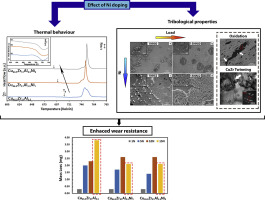当前位置:
X-MOL 学术
›
Mater. Des.
›
论文详情
Our official English website, www.x-mol.net, welcomes your
feedback! (Note: you will need to create a separate account there.)
Strategy for preventing excessive wear rate at high loads in bulk metallic glass composites
Materials & Design ( IF 7.6 ) Pub Date : 2017-12-01 , DOI: 10.1016/j.matdes.2017.09.035 Victor M. Villapún , J. Medina , P. Pérez , F. Esat , F. Inam , S. González
Materials & Design ( IF 7.6 ) Pub Date : 2017-12-01 , DOI: 10.1016/j.matdes.2017.09.035 Victor M. Villapún , J. Medina , P. Pérez , F. Esat , F. Inam , S. González

|
Abstract The effect of nickel additions to tune the wear performance of Cu 45.5 Zr 51 Al 3.5 at.% alloy has been studied to present a new strategy for preventing excessive wear rate at high loads in metallic glass composites. This strategy consists on proper selection of a doping element in controlled concentrations with the ability to decrease the glass transition temperature (T g ) of the alloy so that the friction temperature during sliding is close to the T g . This enables the formation of crystalline phases and their subsequent oxidation (lubricating layer) on the contact surface during sliding thus enhancing the wear resistance. Proper doping can also contribute towards the wear resistance when the content of the doping element promotes the martensitic transformation. The results show that the main wear mechanism for the three studied alloys (Cu 45.5 Zr 51 Al 3.5 , Cu 44.5 Zr 51 Al 3.5 Ni 1 and Cu 43.5 Zr 51 Al 3.5 Ni 2 at.%) is governed by delamination and the mass loss increases with increasing load from 1 to 10 N. However, for the maximum load of 15 N, the calculated friction temperature is close to T g for the Ni-containing alloys and partial crystallization and oxidation take place resulting in a mass loss decrease from about 2.6 mg (at 10 N) to about 2.1 mg (at 15 N).
中文翻译:

防止大块金属玻璃复合材料高负载下过度磨损率的策略
摘要 研究了添加镍对调节 Cu 45.5 Zr 51 Al 3.5 at.% 合金磨损性能的影响,提出了一种防止金属玻璃复合材料高负荷下过度磨损率的新策略。This strategy consists on proper selection of a doping element in controlled concentrations with the ability to decrease the glass transition temperature (T g ) of the alloy so that the friction temperature during sliding is close to the T g . 这使得在滑动过程中能够在接触表面形成结晶相并随后氧化(润滑层),从而提高耐磨性。当掺杂元素的含量促进马氏体转变时,适当的掺杂也有助于耐磨性。
更新日期:2017-12-01
中文翻译:

防止大块金属玻璃复合材料高负载下过度磨损率的策略
摘要 研究了添加镍对调节 Cu 45.5 Zr 51 Al 3.5 at.% 合金磨损性能的影响,提出了一种防止金属玻璃复合材料高负荷下过度磨损率的新策略。This strategy consists on proper selection of a doping element in controlled concentrations with the ability to decrease the glass transition temperature (T g ) of the alloy so that the friction temperature during sliding is close to the T g . 这使得在滑动过程中能够在接触表面形成结晶相并随后氧化(润滑层),从而提高耐磨性。当掺杂元素的含量促进马氏体转变时,适当的掺杂也有助于耐磨性。









































 京公网安备 11010802027423号
京公网安备 11010802027423号